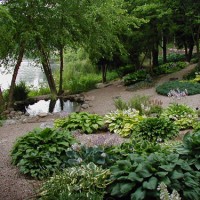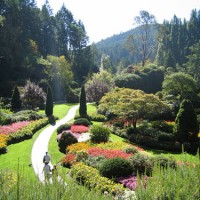America’s Best Botanical Gardens, Part 3: The Midwest and Northwest
This time we look at the Olbrich Botanical Gardens, the Missouri Botanical Garden, the Hidden Lake Gardens, the Toledo Botanical Garden, the Vancouver Island Garden Trail, and the International Peace Garden.
You can view more images in our gallery.
The Midwest
| Olbrich Botanical Gardens (Wisconsin)
Olbrich Botanical Gardens (OBG), located near the University of Wisconsin in Madison, is among the Midwest’s best-kept secrets. It has earned awards in fields ranging from solid architecture to inspirational value. In 2005, it won American Public Garden Association’s National Award for Excellence, an honor given to only one garden a year. Outside, OBG features free admission to 16 acres of captivating areas like the sunken, shade, and rain gardens. Indoors, Bolz Conservatory makes this northern destination great to see year round, with exotic plants, waterfalls, free flying birds and more. OBG is a model in sustainable gardening, responsibly implementing smart water usage, natural insect control, composting and more. |
| Hidden Lake Gardens (Michigan)
Hidden Lake Gardens (HLG), which is operated by Michigan State University, is a 755-acre ode to the four seasons. The essence of year-round nature is captured here, making it a place worth a visit any time. A main attraction is the Benedict Hosta Collection (or “Hosta Hillside”), where over 800 varieties of the plant reside, including Michigan’s own “Hosta Hybridizers.” The Harper Collection of Dwarf and Rare Conifers, miles of trails and of course the Hidden Lake itself all add to the appeal. HLG’s conservatory is home to a Bonsai “forest” with dozens of the miniature trees capturing the imagination of visitors. |
| Toledo Botanical Garden (Ohio)
People like some things universally: pretty landscapes; free things; centers of culture and knowledge. Considering Toledo Botanical Garden (TBG) is all of these, it’s no surprise that over 120,000 come see it every year. TBG is free to the public and offers over 15 thematic areas. A real emphasis is placed on balancing art with nature and, in places like the aquatic, shade, and color gardens, harmony is achieved. Another emphasis is on culture. TBG is home to 19 garden, art, and nature groups and hosts work from over 230 artists during the Crosby Festival of the Arts. Additionally, youth benefit from its educational programs, science benefits from a research partnership with the USDA, and the city benefits from “Toledo GROWs,” a gardening outreach program. |
The Northwest
| Vancouver Island Garden Trail (British Columbia)
Roughly 50 miles from the city of Vancouver off the coast of Canada, Vancouver Island is nature at its most untamed. Home to several Canadian national parks, people come for the untouched mountain terrain and wildlife. Yet, in the wilderness lies a group of cultivated gardens that rival any. The Vancouver Island Garden Trail is several gardens, ranging from less than an acre to grand estates. The temperate coastal climate allows an array of flora not normally found this far north and different plants take turns putting on a color show each season. Fall brings vibrant leaf change; winter provides the stark contrast of snow on evergreen; spring and summer mean the entire wildflower color spectrum. The best way to tour is to ferry from the coast, rent a car and travel at your leisure. Each garden presents unique atmospheres, from small, quaint Ronning’s Garden to large, exquisite Butchart Gardens. |
| International Peace Garden (North Dakota)
Because of this 2,339-acre garden dedicated as a symbol of friendship by the U.S. and Canada in 1932, North Dakota is known as the “Peace Garden State.” It is a favorite destination for citizens of both countries, as well as people the world over. Friendly international relations is a resonating theme – there is an entrance from both sides, and the Maple Leaf and Stars and Stripes are depicted side by side in floral gardens. The Peace Poles project, founded in Japan and dedicated to world peace, has seven poles here that say “may peace prevail on Earth” in 28 different languages. Other features include the Cairn (a border marker made of aboriginal hammerheads from the area), a floral clock, the Peace Tower and the Peace Chapel. A special site is the 9/11 Memorial, where 10 girders collected from the twin tower wreckage help us understand, forgive and grow from the tragedy. |





